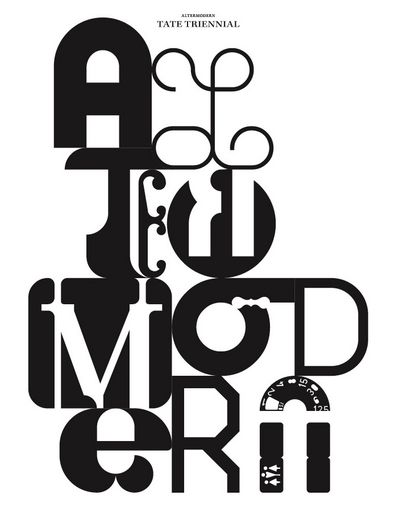Curator:
Nicolas Bourriaud (born 1965 in Niort, France; lives and works in Montpellier, France).
Description:
The Fourth Tate Triennial, on view at the Tate Britain, London from February 3 to April 26, 2009.
“A new modernity is emerging, reconfigured to an age of globalization—understood in its economic, political and cultural aspects: an altermodern culture
Increased communication, travel and migration are affecting the way we live
Our daily lives consist of journeys in a chaotic and teeming universe
Multiculturalism and identity is being overtaken by creolization: artists are now starting from a globalised state of culture
This new universalism is based on translations, subtitling and generalized dubbing
Today’s art explores the bonds that text and image, time and space, weave between themselves
Artists are responding to a new globalized perception. They traverse a cultural landscape saturated with signs and create new pathways between multiple formats of expression and communication.
The 2009 Tate Triennial at Tate Britain presents a collective discussion around this premise that postmodernism is coming to an end, and we are experiencing the emergence of a global altermodernity.
Travel, cultural exchanges, and examination of history are not merely fashionable themes, but markers of a profound evolution in our vision of the world and our way of inhabiting it.
More generally, our globalized perception calls for new types of representation: our daily lives are played out against a more enormous backdrop than ever before, and depend now on trans-national entities, short or long-distance journeys in a chaotic and teeming universe.
Many signs suggest that the historical period defined by postmodernism is coming to an end: multiculturalism and the discourse of identity is being overtaken by a planetary movement of creolization; cultural relativism and deconstruction, substituted for modernist universalism, give us no weapons against the twofold threat of uniformity and mass culture and traditionalist, far-right, withdrawal.
The times seem propitious for the recomposition of a modernity in the present, reconfigured according to the specific context within which we live—crucially in the age of globalization—understood in its economic, political, and cultural aspects: an altermodernity.
If twentieth-century modernism was above all a western cultural phenomenon, altermodernity arises out of planetary negotiations, discussions between agents from different cultures. Stripped of a centre, it can only be polyglot. Altermodernity is characterised by translation, unlike the modernism of the twentieth century which spoke the abstract language of the colonial west, and postmodernism, which encloses artistic phenomena in origins and identities.
We are entering the era of universal subtitling, of generalized dubbing. Today’s art explores the bonds that text and image weave between themselves. Artists traverse a cultural landscape saturated with signs, creating new pathways between multiple formats of expression and communication.
The artist becomes ‘homo viator,’ the prototype of the contemporary traveller whose passage through signs and formats refers to a contemporary experience of mobility, travel, and transpassing. This evolution can be seen in the way works are made: a new type of form is appearing, the journey-form, made of lines drawn both in space and time, materialising trajectories rather than destinations. The form of the work expresses a course, a wandering, rather than a fixed space-time.
Altermodern art is thus read as a hypertext; artists translate and transcode information from one format to another, and wander in geography as well as in history. This gives rise to practices which might be referred to as ‘time-specific,’ in response to the ‘site-specific’ work of the 1960s. Flight-lines, translation programmes and chains of heterogeneous elements articulate each other. Our universe becomes a territory all dimensions of which may be travelled both in time and space.
The Tate Triennial 2009 presents itself as a collective discussion around this hypothesis of the end of postmodernism, and the emergence of a global altermodernity.”
—Nicolas Bourriaud, “Altermodern Explained: Manifesto,” Tate.



